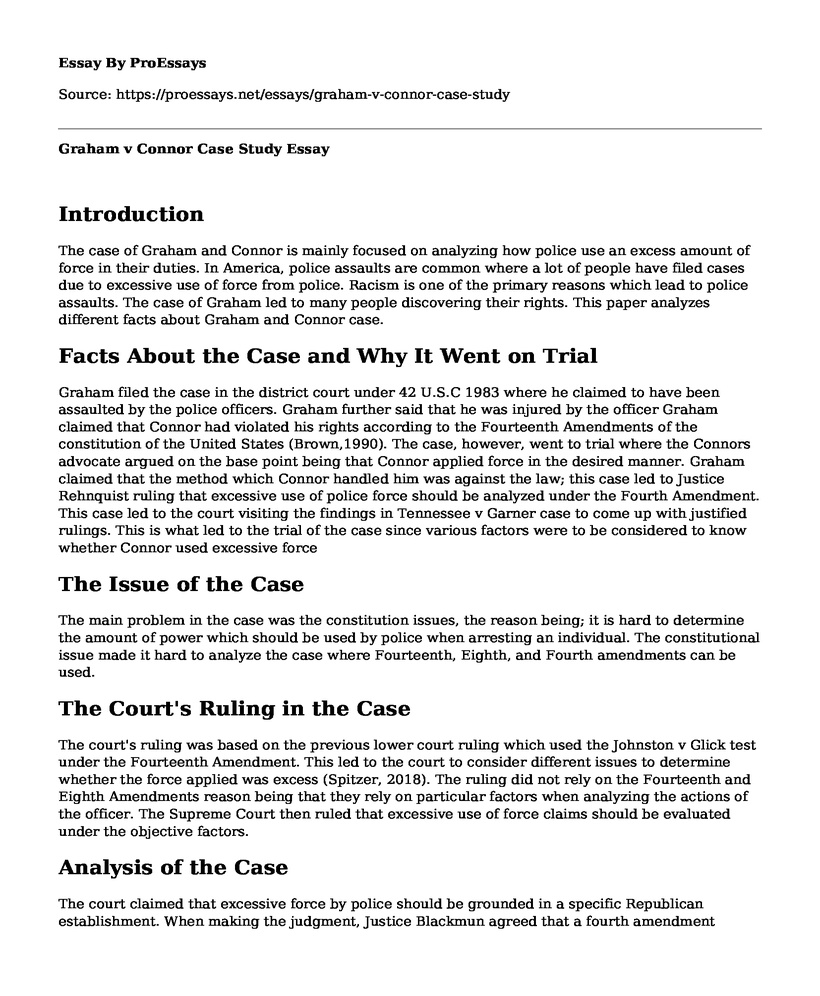Introduction
The case of Graham and Connor is mainly focused on analyzing how police use an excess amount of force in their duties. In America, police assaults are common where a lot of people have filed cases due to excessive use of force from police. Racism is one of the primary reasons which lead to police assaults. The case of Graham led to many people discovering their rights. This paper analyzes different facts about Graham and Connor case.
Facts About the Case and Why It Went on Trial
Graham filed the case in the district court under 42 U.S.C 1983 where he claimed to have been assaulted by the police officers. Graham further said that he was injured by the officer Graham claimed that Connor had violated his rights according to the Fourteenth Amendments of the constitution of the United States (Brown,1990). The case, however, went to trial where the Connors advocate argued on the base point being that Connor applied force in the desired manner. Graham claimed that the method which Connor handled him was against the law; this case led to Justice Rehnquist ruling that excessive use of police force should be analyzed under the Fourth Amendment. This case led to the court visiting the findings in Tennessee v Garner case to come up with justified rulings. This is what led to the trial of the case since various factors were to be considered to know whether Connor used excessive force
The Issue of the Case
The main problem in the case was the constitution issues, the reason being; it is hard to determine the amount of power which should be used by police when arresting an individual. The constitutional issue made it hard to analyze the case where Fourteenth, Eighth, and Fourth amendments can be used.
The Court's Ruling in the Case
The court's ruling was based on the previous lower court ruling which used the Johnston v Glick test under the Fourteenth Amendment. This led to the court to consider different issues to determine whether the force applied was excess (Spitzer, 2018). The ruling did not rely on the Fourteenth and Eighth Amendments reason being that they rely on particular factors when analyzing the actions of the officer. The Supreme Court then ruled that excessive use of force claims should be evaluated under the objective factors.
Analysis of the Case
The court claimed that excessive force by police should be grounded in a specific Republican establishment. When making the judgment, Justice Blackmun agreed that a fourth amendment analysis was necessary for the pre-arrest situation. Blackmun claimed that the court did not need to exclude the use of functional due to process standard in future cases. To determine if the officer used excessive force, the court decided to analyze the situation reasonably by examining how another officer would have acted in the same position. The objectively standard in the Fourth Amendment which requires facts and circumstances surrounding the officer to be analyzed. The court examined the act where the officer actions were analyzed to determine whether the applied force professionally. Graham actions were revealed to decide whether or not he was resisting arrest and if he made any threats to the officer (MacDonald, 1990). New strategies which ensure officers apply the needed amount of force should be incorporated. For instance, policies that restrict police to apply excessive force should be implemented. Officers should also be trained in various ways which they can use rather than excessive force. Police officers should also have objectively reasonable facts which justify their actions.
Conclusion
To conclude, the excessive amount of force applied by police should be curbed. The public should also be educated about constitutional rights. However, in many cases, people who threaten the police are likely to force police to apply more force. Some suspects resist an arrest which makes officers apply more force. It is, therefore, necessary to educate the public on the importance of cooperating during arrests. Introduction of policies which protect suspects and the safety of police when conducting arrests should be implemented.
References
Brown, J. I. (1990). Defining Reasonable Police Conduct: Graham v. Connor and Excessive
MacDonald, E. B. (1990). Graham v. Connor: A Reasonable Approach to Excessive Force Claims Against Police Officers. Pac. LJ, 22, 157.
Spitzer, Elianna (2018). Graham v. Connor: The Case and Its Impact. ThoughtCo. Retrieved from: https://www.thoughtco.com/graham-v-connor-court-case-4172484
Cite this page
Graham v Connor Case Study. (2022, Dec 03). Retrieved from https://proessays.net/essays/graham-v-connor-case-study
If you are the original author of this essay and no longer wish to have it published on the ProEssays website, please click below to request its removal:
- Drug and Substance Abuse Among Teenagers - Essay on Social Problem
- Inequality in Education Annotated Bibliography
- Feminist Legal Theory Essay Example
- Essay Example on Traversing to Work: The Complexity of My Commute
- Essay on Black & White in America: The Ongoing Divide
- Essay on Women Overcome Gender Inequality, Increase Bachelor's Degree Attainment
- Stereotypes and Poverty: Examining the Impact on Minorities - Essay Sample







